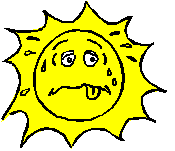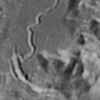
Personal Acuity once more
#1

Posted 13 September 2013 - 10:39 AM
Pete reports a split of Eps Lyr with a magnification of x70. This is certainly plausible and I know other claims of even lower magnification for doing this. This means a personal acuity of about 150 arcseconds for resolving two equal bright stars.
This should allow an educated guess about the required magnification to "see" an elongation - my guess would be about half the magnification giving x35. Personal acuity for dedecting elongations would then be 75 arcseconds.
If only personal acuity is the critical issue (and not optical quality of the used scope and seeing) then the detection of an elongation for a 0.2" equal double would require a magnification of x375 as minimum if other conditions (scope, seeing, ...) provide a really crisp image. In my personal experience (with most of the time not this good seeing) the sweet spot of magnification for a given aperture is about D_mm * 1.5 as higher magnification leads to fuzzy spots instead of crisp disks - this would give a necessary aperture of 250mm for detecting an elongation for an 0.2" double.
Wilfried
#2

Posted 13 September 2013 - 08:53 PM
Personal acuity will tell what the individual can see; diffraction will determine what's there to be seen. The interaction between the two might be thought simple, but it seems, from the observing experience of many of us, not to be as straightforward as one might expect.
The atmosphere obviously plays a significant role in that, because images are very rarely entirely steady, and seeing the flickering patterns, and discerning stars within those patterns, can be difficult - and false positives are possible as we know.
I'm inclined to think, as I noted in another thread today, that elongation of sub-Rayleigh, sub-Dawes doubles is somewhat more straightforward than unequal doubles. And that false positives are less likely, though they can still happen.
When we get to unequal pairs, especially those of major brightness difference (say, delta-m of 3 or more) the play of diffraction patterns amid flare from bright primaries, or the difficulty of seeing dim secondaries, seem to be subject to multiple factors. And with some pairs there can be a problem of having to use averted vision - with its lower resolving ability - for the fainter companions.
That in turn is why the brighter versions of fairly large delta-m pairs are more likely resolvable/visible than the pairs where the secondary star is 10th magnitude or less.
The well-known experience, remarked on by Aitken, that much less bright companions typically look fainter than they are when close to the much brighter primary; and the frequent experience of spurious lesser star images created by atmospheric seeing, creates a recipe for difficulty seeing the signal through the noise, plus an invitation to see what can't be seen (with that telescope on that night - and by that observer in those conditions). [There's a can of worms there, for further discussion later]
The suggestion about 0.2" pairs (equal) with 375x and 250mm is I think fair if we have the telescope in space, rather than on earth, and an observer with very good eyesight.
In the conditions more typically encountered by observers, assuming a good steady atmosphere, though not perfect, etc etc, I'd expect 300mm rather than 250mm for 0.2" (as per Aitken), and rather more magnification - with that aperture, you're at about 0.45R (Rayleigh), and based on my own observing, and what I've seen from expert observers, I'd think Couteau's formula for the useful magnification, set at up to 5 times the resolving magnification, would be needed. That, for 300mm, is 750x (five times). 600x might be enough for some observers (4 times resolving magnification).
The term "resolving magnification" is somewhat misleading, as it refers to the size of the first ring being equal to the limit of visual acuity, supposed to be 1 arc minute - but for most observers, it's in the range of 120" to 180", and Pete's experience with Epsilon Lyrae is yet another example that supports this.
While I agree that higher magnification than D_mm * 1.5 typically leads to "fuzzy spots instead of crisp disks", I find there's a little more visual information available despite that. Couteau suggests that it's when you go beyond the 5-times-resolving-magnification that "the edges of the image are badly defined and the eye cannot transmit information". Up to that point, there can be benefits.
The above thoughts are not intended as a final summary of the issues involved. See them, good people, as an opportunity for discussion and debate.
#3

Posted 13 September 2013 - 11:03 PM
I think my sub arc arc second aspirations to hit 0.2" will have to wait till next summer. The cooler nights make those 8 Pickering or better evening too rare to count on . These days with the jetstream drooping down again, 7 Pickering is as good as it gets and by December its 4 to 6. I've NEVER in my life had a 9 Pickering in the dead if winter.
All that to say, again, my 0.2" (or close as I can get) is suspended till hot balmy nights resume next year. Frankly 0.2" may just be too hard and I can live with that. Its a soft goal . I want it but - I'm fine without it. Its the exercise of seeking it that engages me.
At anyrate I withheld this from a post but Ill run it here . I wanted more observations to see if repeatability was possible to rule out, say, atmospheric refraction and such . At anyrate the star was Delta Equulei. I was using 545x with the 8" and without prior knowledge I studied the star for any sign of PA. As it turns out I noticed the elongation ( actually just a slight fatness) seemed 90 degrees to its drift path to the west or said another way 90 degrees from the preceding/following line of travel across the field. This was a persistent though often invisible pressions as only the best moments had shown this and even then I wondered if the seeing might be stretching it. Well further study showed it wasn't exactly 90 degrees and the angle of "fatness" appeared slightly kicked to one side just shy of a true 90 - that 90 isn't a PA number but my own call on its angle versus travel line. As it turns out this call jives extremely well with the PA of 198 degrees!!!!
Did I really see a .3" "fatness" (or.32") - its impossible to say with certainty as other evenings are needed to quantify results. At this point I do know its PA now but frankly - Im not compelled to force it. If the PA appears to travel around the compass rose then its clear atmospheric refraction is greater than the detail itself. If like Chi Aquilae its a persistent thing then Id be inclined to think its elongation was detected.
One thing that's a compelling thing for me here is the need for repeated tests to quantify results. Other doubles not so drastically tight might take a number if try's to see it, but when it pops it pops. Here though it would appear that a more careful methodical approach is needed to arrive at a pop. And even if the pop is atmospheric refraction, its still interesting. It would describe the boundaries of my acuity and scope to me and that's a lot of fun actually. At any rate I think its on hold till next summer. Nice to end the season of best seeing with a question mark.
This is a nice thread Wil. Nice points Fred.
Pete
#4

Posted 14 September 2013 - 04:37 AM
I always consider the Double Double (eps Lyr) to be an easy split with around x50 with a 4" bigger scope (providing the seeing isn't awful) but it takes me x70 or more to resolve with 60mm. Eps Lyr is easy for me to detect elongation at a lower magnification than required to resolve because the axes are in very different orientations. An unresolved double star often just looks "odd" or "unfocused" to me rather than elongated, unless the seeing is good enough to support a very high magnification.
#5

Posted 14 September 2013 - 01:37 PM
It does seem intuitive image scale can help with elongation of very tight pairs requiring, as image scale on the retina plays a role in acuity. As Fred said, something closer to 5 times resolving power seems helpful. I'm sure there is a way to calculate at what magnification a double star's spurious disc reaches a given arc second apparent size on the retina. Trick is, how big should it be - well above the minimal 120" or so, it would seem.
I haven't been that high very often, so can't speak to the softness of the Airy disc nor how it would make elongation more difficult - other than maybe dragging the already difficult observation into that fuzzy edge. So, how fuzzy the edge of the Airy pattern is might play a role in success or failure. I did go up to 150x per inch out of curiosity (looking for astigmatism during star testing.) I was surprised how well good seeing preserved the Airy pattern. It' looked huge, but it was all there.
One of the interesting revelations is how an unequal pair can certainly appear easy enough with a liberal separation and both magnitudes easily within reach of the aperture. But, they are not easy. That was shocking, presents a challenge for both observer and equipment, and probably requires very good conditions to peak out those types of observations.
One's sensitivity to faint point sources, and again high power may help. Though you can darken the sky relative to the point source, the residual diffraction may also fade in the way an extended object fades. But, at very high power the Airy disc also begins to act as an extended object on the retina. It will begin to fade, too. There might be an optimal range of magnification where the Airy disc is still essentially acting like a point source but still allow one to expand the diffracted light in the rings to some degree. (I dunno if the rings behave as expended objects and fade with object size. I assume they might, so just throwing that out there.) If so, then getting the magnification right might be the best chance for success.
#6

Posted 14 September 2013 - 03:09 PM
I need for example for Eps1 Lyr a magnification of x75 to get a clear split and this only with very good conditions otherwise - 2.3"x75 gives then a personal acuity of ~170 arcseconds. I found this confirmed on many occasions with some variation of +/- 10 arcseconds. It is quite helpful to know your own personal acuity for double star observing as this gives you a clear indication which magnification you need at least to expect a split. For unequal bright doubles you need usually a bit more magnification for a split but with some experience you get some feeling also for this. And if you don't get an expected split you know you have a small research project on hand - either your expectation was wrong or the advertised data.
Wilfried
PS: And if you are specifically interested in personal acuity for other tasks like recognizing elongations you can then apply this logic accordingly
#7

Posted 14 September 2013 - 03:59 PM
#8

Posted 17 September 2013 - 01:46 PM
For an advertised separation of 1 arcsecond this means already an error range of 9% and for an advertised separation of 0.3" this means a huge error range of 30%. Conclusion: The smaller the separation the higher the measurement error range.
This is also a big problem for my RoT algorithm as for a 0.3" +5/5mag double this means a from the Dawes criterion derived range for the proposed aperture from 341mm to 464mm - the difference is a nice 120mm scope in itself.
Wilfried
#9

Posted 17 September 2013 - 08:48 PM
Quantifying observations helps here as well. So far the .32 Delta Equueli is in step with difficulty from Chi Aquilae. So the .32 is about right on the money.
Pete
#10

Posted 17 September 2013 - 10:12 PM
That sep is a Dawes split and not elongation. Simple elongation requires smaller aperture. How small is the question.This is also a big problem for my RoT algorithm as for a 0.3" +5/5mag double this means a from the Dawes criterion derived range for the proposed aperture from 341mm to 464mm...
Your points on measurement error are spot on and the data is too often not current (I think Fred extrapolates it a bit based on the orbit and timing of the observation.) We do the best we can with the data we have.
But, if Pete can get down to 0.3" elongation, that should blow 0.4" elongation limit out of the water. Does the RoT give reasonable expectations for elongation, or simply a Raleigh or Dawes split?
#11

Posted 18 September 2013 - 12:37 AM
Extrapolate measures? occasionally; more often I interpolate within the WDS ephemeris figures in the 6th Orbit Catalog. Or interpolate within a long series of measures, for doubles that don't yet have an orbit calculated.
On another matter - magnification again. I remembered that Aitken has some comments on this in his classic work The Binary Stars (2nd edition, 1935). Although he discusses this in the context of measuring, I think it's still informative, as you need images that are reasonably coherent when using a bifilar micrometer.
Aitken says that for the closest doubles, those under 0.5", he used powers from 1,000 to 3,000 on the Lick 36-inch. The "resolving magnification" for the 36-inch is 457x; 5 times that, as per Couteau, is 2286x. So in fact Aitken was willing to go as high as ~6.5 times the "resolving magnification".
To scale that down to telescopes such as most of us have available: that's about 460x for a 140mm refractor, 665x for an 8-inch scope, 770x for a C9.25, and 1040x for a 12.5-inch. That last is higher than Christopher Taylor used for his remarkable elongation observations. If Taylor went with Couteau, at 5 times rm, that gives 793x - similar to Taylor's 820x.
Did Aitken used higher powers than some observers because his eyes were, as he says, "not so keen as theirs were"? - referring to Burnham and Barnard; whatever the explanation, he obviously found the extreme magnifications useful on occasion.
#12

Posted 18 September 2013 - 02:28 AM
... Does the RoT give reasonable expectations for elongation, or simply a Raleigh or Dawes split?
Norme, for equal bright doubles it gives Dawes for refractors and somewhat less than Dawes for reflectors - target of the RoT is giving an aperture for a good chance of definite resolution with confident position identification and not lucky guessing if an assumed elongation is pointing at the right position. And main RoT target are anyway unequal doubles using Dawes only as starting point.
Wilfried
PS: Had too many "elongations" leading to nothing that I don't even include the occasional lucky hit in my data set of limit observation - at least a clear rod or very pointed elongation giving the position without any doubt is required
#13

Posted 18 September 2013 - 05:35 AM
That's what I was trying to get across. Nothing wrong with doing so, in fact it's smart to update old reported figures using an educated method....more often I interpolate within the WDS ephemeris figures...
Resolution to 0.5" doesn't seem impossible for a modest aperture as it is still above 0.5R. I've gotten close and it was easier than expected in reasonably good seeing at 300x. It's comforting star images are still well defined into 400's and above. Whether the images are good enough to put up a resolution approaching 0.5R remains to be seen. Chi Aql is right at that border and is a perfect test of man, machine, and mother nature.
It is probably helpful to bracket a series of double stars reported near 0.5R to ensure one get's one or more that actually are at that sep. Restricting an observation to one star is not conclusive as it could very well could be above or below that limit. Maybe a statistical analysis can be applied to a sample of very close double pairs to arrive at successful angle of separation.
#14

Posted 18 September 2013 - 08:25 AM
Then it sounds like you need to be more systematic in your observation. Lots of things can smear a star into an pseudo elongation. Cumulatively the truth should surface as to the true orientation. When it doesn't then all is not lost in data. It simply means a particular double is indistinguishable from a single star. No reason not to explore the threshold though - merely a slightly different methodology where results are accumukated rather than a single definitive yes or no .
Pete
#15

Posted 18 September 2013 - 03:11 PM
...Then it sounds like you need to be more systematic in your observation. Lots of things can smear a star into an pseudo elongation. Cumulatively the truth should surface as to the true orientation. ...
Pete, don't think so, I am very systematic in my observations but accept only confident resolutions as limit observations if done with the smallest possible aperture (I use an iris diaphragm for this purpose - for observations of others with fixed aperture I can only accept their opinion that this was more or less on their limit). I generally consider therefore vague elongations not as resolution as long as determination of position is a guessing game.
Regarding hunt for records: I have only average personal acuity of about ~170 arcseconds and do therefore not participate in such a hunt - but would also not do it otherwise as I doubt the value of such a hunt. In my quest for a Rule of Thumb for resolving unequal binaries there is no place for personal records as it should be a RoT of general use. My calculation above for personal elongation acuity is to be considered as non practical as I have demonstrated the numerical insignificance of such an approach.
Wilfried
#16

Posted 18 September 2013 - 04:48 PM
On a couple of occasions, with really good "seeing" I have managed x51.
On the other hand I always struggle to get below x70 with my C6 and x100 with my C8. Both look spot on with a star test.
I'm pretty sure it is not "personal acuity".
#17

Posted 18 September 2013 - 05:34 PM
Pete
#18

Posted 19 September 2013 - 12:20 PM
Like Dawes you could sample several hundred observations with different apertures (masks would be useful) and then do some calculations to derive a nn/D_mm formula. I would certainly contribute some observations around the 1 arcsec range by first resolving and then reducing the aperture to the degree of elongation.
Wilfried
#19

Posted 19 September 2013 - 09:08 PM
#20

Posted 19 September 2013 - 09:39 PM
The Azure limit, somewhere between Dawes and Sparrow.
Nah - way beyond Sparrow. Sparrow is a wimp.
Azure limit is where the seeing interacts with the mirage effect, so you hope that what you're seeing is real beyond that hazy horizon of established possibility ....
#21

Posted 19 September 2013 - 09:40 PM
I do like Wilfrieds suggestion of multiple masks of differing apertures. Saves me having to scour the sky for various doubles that must fit a very narrow separation and magnitude criteria.
Pete
#22

Posted 19 September 2013 - 10:16 PM
A hard limit would be set by diffraction where the PSF became as one. The Azure limit would be empirical. Right now, observation seems to suggest just a hair under 0.5R.
#23

Posted 19 September 2013 - 10:43 PM
- went out tonight - the forecast was good to great seeing. After an hour with the fan running the Altair was a nervous hair ball of morphing confusion. I hoped based in Cleardarksky.com that this would be my last chance for high res but ehhh - it looked like 5/10 seeing. Noghts like this top out around 173x- 200x. I think my sub second aspirations are going to sit on winters ice till spring thaw. Ill keep trying though.
Pete
#24

Posted 20 September 2013 - 06:08 AM
Want just to point out that I do not consider very close doubles as good reference point for estimating personal acuity - the reason is simply a numerical: As measured separations are given in single digit decimals (exception are calculations of orbits but these are not necessarily more precise than direct measurements) this means that the "real" separation may be somewhere in between the rounding boundaries. This is no problem for example for 3 arcsesonds as this means "real" separation between 2.95" and 3.04" - an error range of in total 0.09 or 3%.
For an advertised separation of 1 arcsecond this means already an error range of 9% and for an advertised separation of 0.3" this means a huge error range of 30%. Conclusion: The smaller the separation the higher the measurement error range.
This is also a big problem for my RoT algorithm as for a 0.3" +5/5mag double this means a from the Dawes criterion derived range for the proposed aperture from 341mm to 464mm - the difference is a nice 120mm scope in itself.
Wilfried
Another good candidate to test you acuity is 65 Psc. I run on this double by chance in my 80mm scope. This is equal pair with optimal ~6mag brightness (6.3+6.3). It is not too close as well (4.3" in 2004 according S. Haas book).
I was able to see it as two close distinct needle-points in my 40mm Kellner eyepiece. This was providing 30x magnification in my 80/1200mm refractor. Which means that I was able to split two point sources at distance of about 130" (2.2'). Unfortunately, I did not have anything longer at hand to see how low I could go.
#25

Posted 21 September 2013 - 12:36 AM
The Azure limit, somewhere between Dawes and Sparrow.
Nah - way beyond Sparrow. Sparrow is a wimp.
Azure limit is where the seeing interacts with the mirage effect, so you hope that what you're seeing is real beyond that hazy horizon of established possibility ....
Yeah but - that hazy horizon is so compelling! So we'll call it the Horizon Limit.
Alexander thanks got the suggestion and accounts.
Pete

























